
Somewhere deep down, every person wants to be his own master. But not everyone is cut out to script their lives that way. While starting up a business is still not easy, it is surely easier than it used to be.
The biggest barrier earlier, initial capital required, has crashed with falling price of computing and telecommunication, making it cheaper to set up, manage and publicise a business.
The growing confidence of Indians, too, has allowed many of them to walk riskier roads. So, it's not surprising that many of our new entrepreneurs are in their 20s or just out of it. It also proves that rather than loads of capital, it is possible to make a go of it if you have a good enough idea.
Over the next few slides, we take a look at the areas that are throwing up new business opportunities. There is always a greater chance of cracking it in an emerging area, where the rules have not been written, rather than in established industries, where they have.
We also list 25 businesses that were started for an initial capital outlay of Rs 10 lakh (Rs 1 million) or less. For an entrepreneur, it is always a leap of faith and getting the direction right could help.
In the first of a 6-part series, we bring you the industries that are likely to make it big in future and the 25 hottest start-ups .Watch this space for Part II: 5 exciting start-ups under Rs 10 lakh!
Click on NEXT to read more on the sectors that offer a good potential to entrepreneurs, its success factors and challenges...

When a country has the second-fastest growing mobile telecom market in the world - the Department of Telecom forecasts that the mobile-user base will go up to 1 billion connections by 2014 from about 500 million today - the business opportunity is obvious.
What's more, there will be a qualitative difference in what mobile phones are used for. With the advent of 3G and the falling prices GRPS/3G-enabled handsets, more Indians are going to access the Net through their mobiles.
Hot Areas Indus Khaitan, partner, The Morpheus, an incubation firm that engages with early-stage start-ups, bets on India-specific content creation for GPRS phones and mobile payment systems as the two lucrative areas. The other big opportunity is in mobile applications (apps) and mobile advertising.One more area that holds tremendous opportunity, according to Karam Laxman, program manager, iAccelerator, an incubator of Internet and mobile start-ups, is SMS-based applications for the rural market, which has a large number of fairly basic mobile handsets.
Click NEXT to read more...

Challenges
For mobile app developers, the biggest hurdle is distribution. Users need to download them through a GPRS or 3G connection (which many do not have), or from a website. Unless a mobile service provider supports it, an app is difficult to sell.It's a catch-22 situation here: unless an app has enough users, phone companies don't distribute it and unless they distribute it, there aren't enough users.
Besides, telecom service companies grab a lion's share of the revenues. That apart, a lack of standardisation of mobile platforms limits the number of phones that can use it. Developers targeting the rural market face the additional challenge of creating product awareness and breaking down the language barrier.
Critical success factorsIt is important to understand that users have totally different expectations when he is using his mobile. "The user who will wait for a document to load on his PC, will want his mobile app to open immediately," says Laxman. The smaller screen size also necessitates a different interface. Understanding the need of the user and creating a simple and effective solution is the key.
Click NEXT to read more...

These are what Silicon Valley dreams are made of. The least capital intensive business to start - there are enough tools available to get a website up and running in a couple of weeks.
And the Net, by its nature, breaks boundaries and helps scalability, giving a website the access to a global audience without having to spend on establishment costs.
Hot Areas
The Indian Web market is getting crowded, but opportunities are still there. "Those who can exploit a narrow niche that is currently not served or under-served by the big integrated portals can, thus, leverage their knowledge of the market," says Rahul Dev Gupta, CEO, Kuruvindum, a nurture and finance organisation for tech start-ups.
Click NEXT to read more...

Challenges
Poor Internet penetration in India creates its own set of problems. Then, unless it is an e-commerce website, creating a revenue stream is tough even with reasonably good traffic.
It's tough to survive solely on ads as Net users are either not viewing ads, or installing ad-blocking software.
Vinayak Hegde, director, HeadStart, a network that promotes the innovation ecosystem in India, says what works is the premium model. In this, a website (such as Flickr) first engages a certain community of people by offering them free services and then charges a subscription for premium features. A hybrid model works too. "If you pay for premium services, you can browse ad-free," explains Hegde.
Critical success factors
Getting traffic on the site through search engine optimisation is not the end. The trick is to keep them there by creating communities by offering a unique and addictive value proposition that no other website does.
The portal, yoplr.com, for instance, helps its users customise a travel itinerary, the first step in travel planning that the large travel portals do not offer. Hegde also suggests an offline component to create a strong community.
Click NEXT to read more...

After the PC and the Internet, information technology has come upon its third big game changer - cloud computing - that is the happy hunting ground of start-ups.
Hot Areas

Challenges
Start-ups in this area have to outmanoeuvre incumbents and free SaaS applications that meet most of an SME's needs. Marketing is a challenge too. The sales cycle for a B2B client is about six months. So, that strains a start-up's resources.
Critical success factorsThe solutions lie in the challenges themselves. Ethan Khatri, India head, Angel Investment Network, which brings together entrepreneurs and angel investors, says that start-ups need to develop niche products with a competitive edge. So, deep domain knowledge is critical.
Moreover, start-ups should not be hung-up about what they think will work, but rather get the concept validated from their potential end users. They also need to take advantage of their low overheads to compete on price.
One way of differentiating a product is to offer a high level of customisation and a strong support team, things a free SaaS application will not offer.
Click NEXT to read more...

The government's failure to provide quality education to the masses, a growing young population, a willingness to spend more here, an increasing preference for private education and effective technology solutions has totally opened up this sector.
Hot Areas
For start-ups, e-learning holds greatest promise. Technology has made it possible to disseminate high quality education even to tier-II cities and rural areas from a centralised studio.
With employability being an issue, providing vocational education or English language courses over the Net to prepare candidates for jobs is lucrative too.
In fact, A 2008 CLSA Asia Pacific report says this segment of the market will grow at 60 per cent a year even as the overall sector grows at 16.2 per cent.
The focus should ideally be on content with platforms sourced as cheap as possible by renting-on-demand. There is also a lot of demand for portals that aid online test preparations for exams, such as CAT for management studies.
Click NEXT to read more...

Challenges
A key issue with education start-ups is scalability. The solution is to use innovative technology to create a replicable business model.Ram Mohan, CEO of Edyounet Technologies, which has developed the Edyounet TeleClassroom, a classroom network for rural India, has done that by implementing a franchise model and now has 15 of them in Kerala.
Start-ups also need to focus on building up their brands, as that pulls in students, and publicising the value that it provides in terms of jobs.
Critical success factorsRaghu Rajagopal, programme co-ordinator of the Chennai Fund, which is facilitated by the members of TiE, Chennai, to help early-stage start-ups, says the issue of authenticity can be solved by validation of the programme by recognised industry experts. Co-branding with established institutions could also help.
TeleClassroom, for example, offers vocational courses that industry bodies offer on banking and mutual funds.
Click NEXT to read more...

Laura Parkin is thrilled. The CEO of National Entrepreneurship Network, which helps create and support high-growth entrepreneurs, says: "Young people today are spending their time and energy to find innovative ways of addressing key challenges that our society is facing. That, in turn, is providing them with lucrative business opportunities."
This union of development and economics opens up the area of clean tech, products or services that use renewable energy sources to cut dependence on natural resources.
A PEW Environment Group study says India's clean tech market has a five-year expected growth rate of 72 per cent.
Hot areas
These include rural distribution of energy efficient products such as solar lanterns and cookers, and water/waste management. Another promising area that doesn't need too much of capital up-front is sustainability consulting, i.e., advising companies on improving the energy efficiency.
Click NEXT to read more...

As it's a new concept, it's tougher to sell and convince customers to pay up-front for future benefits. Talking in terms of improving profits helps, what with energy costs rising to up to almost 10 per cent of total production expenses in some industries.
Besides, many companies want to be seen as green brands. Anil Paranjape, an advocate of and an investor in clean tech, says linking fees to the money saved by clients will help a consultant do well.
For B2C customers, especially in the rural areas, the stress could, likewise, be on savings. Finding a scalable model, or mentors, isn't easy though.
Critical Success Factors
Manoj Gupta, founder and CEO, Nexus Venture Partners, a venture capital fund, says that blindly copying a Western model- they have been at it longer than us- may not work in India.
"Entrepreneurs need to look at India-specific problems and solve them," he says.
Click NEXT to read more...

The biggest challenge for all new businesses is raising capital. An initial amount is needed to develop the product or service, bring it to the market, and keep it running till cash starts flowing in.
Most businesses with a low start-up capital, like the ones we have covered, have been self-financed. For some, it could come from the prize money of a business plan competition.
The other option is getting funded by angel (seed) funding agencies (around Rs 5 lakh-Rs 15 lakh) based on a prototype or even an idea. It's still tough, but is getting better. Angels funding can also bring with crucial early-stage guidance and mentoring.
Setting up and running your own venture is like bringing up your baby. It's tough all right, but the satisfaction is worth it.